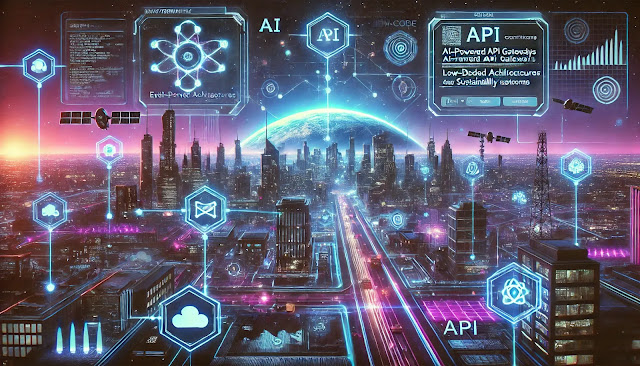We’re entering the era of AI-native APIs—tools that don’t just move data but think, adapt, and predict. As industries from healthcare to fintech double down on digital transformation, APIs are evolving from mere connectors to business-critical assets. Below, we dissect the trends poised to dominate 2025 and share actionable steps to keep your stack ahead of the curve.
1. AI-Powered API Gateways 🧠🚀
The Shift: Traditional gateways route traffic; future ones optimize it intelligently.
🔥 Why It Matters:
Predictive Load Balancing: Tools like Kong AI Gateway now use ML to anticipate traffic spikes, rerouting requests before outages hit.
Anomaly Detection: Spot API attacks in real-time using behavioral analysis (e.g., sudden payload size spikes).
Auto-Documentation: Tools like BlazeMeter generate OpenAPI specs via live traffic monitoring.
✅ Prepare Now:
✔ Test AI-driven gateways (Kong, Tyk) in staging environments.
✔ Train teams on “MLOps for APIs” to manage model-driven routing.
2. Composable APIs: The Lego-ization of Software 🏗️
The Shift: Companies like Stripe and Twilio proved APIs can be products. Now, micro-APIs let you assemble workflows like Legos.
🛠️ Example:
Shopify’s Modular API allows merchants to mix payments, logistics, and AR try-ons in one checkout.
Uber’s "Route Kitchen" chains location, traffic, and restaurant-prep-time APIs to optimize meal delivery.
✅ Prepare Now:
✔ Break monoliths into “single-responsibility” APIs (auth, geo, billing).
✔ Adopt API-first design tools like Stoplight.
3. GDPR-Level Security for APIs 🔐
The Trend: By 2025, expect API-specific regulations akin to data privacy laws.
⚠️ Risks:
42% of companies had an API breach in 2023 (Salt Security Report).
Attack vectors like shadow APIs (unmanaged endpoints) and greedy data responses.
🛡️ Solutions:
Automated Posture Management: Tools like Noname Security inventory all APIs and enforce governance.
Zero-Trust Gateways: Require continuous authentication via OAuth 2.1 and mutual TLS.
✅ Prepare Now:
✔ Audit APIs quarterly using tools like Postman’s API Network.
✔ Adopt Open Policy Agent for granular access controls.
4. Event-Driven Architectures (No More Polling!) ⚡
The Shift: REST’s “ask-and-receive” model is yielding to real-time systems.
🔥 Drivers:
IoT (e.g., live tracking of EV battery health via webhooks).
Financial trading APIs requiring sub-10ms latency.
🔧 Tools to Watch:
Apache Kafka: Dominates in event streaming (used by LinkedIn, Netflix).
WebSocket APIs in AWS API Gateway: Cheaper than REST for real-time apps.
✅ Prepare Now:
✔ Retrain devs on event sourcing patterns.
✔ Benchmark WebSockets vs. Server-Sent Events (SSE) for your use case.
5. Low-Code API Ecosystems 🤖
The Trend: Non-devs are building APIs.
🔨 How:
No-Code Platforms: Retool lets teams spin up CRUD APIs via drag-and-drop.
Natural Language: OpenAI’s GPT-4 writes Swagger docs from plain English prompts.
💡 Use Case:
A healthcare startup used Bubble.io to launch a HIPAA-compliant patient-data API in 3 days.
✅ Prepare Now:
✔ Create internal APIs for business teams using tools like Airtable.
✔ Guard against “low-code sprawl” with centralized API catalogs.
6. Sustainability Metrics in API Design 🌱
The Demand: Green coding isn’t optional anymore.
📊 Stats:
A single API call can emit up to 3g of CO2 (ClimateCalc).
Amazon’s Carbon SDK lets devs measure API-driven emissions.
✅ Best Practices:
✔ Optimize payloads (replace JSON with protobuf for 60% smaller sizes).
✔ Cache aggressively using CDNs like Cloudflare.
✔ Sunset deprecated APIs to reduce server load.
✅ Prepare Now:
✔ Add carbon budgets to API SLAs.
✔ Adopt eco-friendly hosting (e.g., Google Cloud’s carbon-neutral regions).
7. Interplanetary APIs: Edge Computing Meets Space 🚀🌍
The Wildcard: SpaceX’s Starlink and IoT in remote areas demand APIs that work anywhere.
🔬 Innovations:
Delay-Tolerant Protocols: NASA’s BPv7 sends data across satellites with intermittent connections.
WebAssembly (Wasm): Run APIs on edge devices (e.g., Tesla cars processing sensor data locally).
✅ Prepare Now:
✔ Explore Fastly’s Compute@Edge for lightweight API runtimes.
✔ Test fallback modes for low-connectivity scenarios.
🚀 How to Future-Proof Your API Strategy
✔ Audit Relentlessly: Use tools like Postman to find outdated, insecure, or redundant APIs.
✔ Invest in Observability: Track not just uptime, but CO2, cost-per-call, and business KPI impacts.
✔ Upskill Teams: Train devs on GraphQL, event-driven systems, and AI-augmented tooling.
✔ Partner Strategically: Leverage API marketplaces like RapidAPI to monetize or integrate niche capabilities.
🎯 The Bottom Line:
APIs in 2025 won’t just be pipes—they’ll be brains powering adaptive, ethical, and sustainable systems. Start rewiring now, or risk becoming a digital fossil.

Comments
Post a Comment